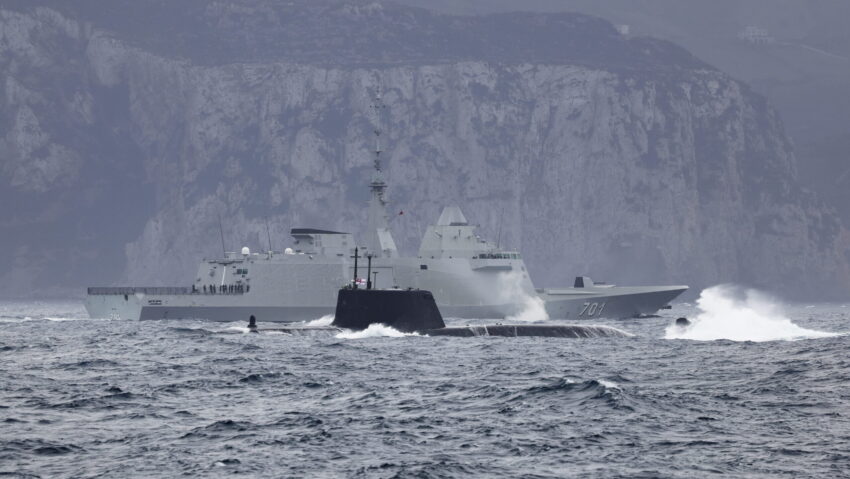The UK Royal Navy’s HMS Astute SSN passes a Moroccan frigate off the coast of Morocco (UK MoD)
BELFAST — It will take huge investment in local shipbuilding for the UK to acquire “up to” 12 nuclear-powered attack submarines (SSNs) under the trilateral AUKUS program, with each vessel estimated to cost $3.4 billion, according to analysts. Even then, potential obstacles tied to shipyard expansion, and financial risk for BAE Systems could conspire to ruin the big ticket procurement altogether, said one expert.
The commitment to build as many as a dozen of the future submarines to replace seven Astute-class boats was perhaps the most eye-catching part of the UK Strategic Defence Review, despite the failure to share any costs associated with the grand naval plan.
“We can’t tell the precise cost of what those subs will be,” UK defense minister John Healey told LBC radio Tuesday, adding that the Ministry of Defence (MoD) is only at the the stage of calculating a working estimate.
Building the 12 subs, which are expected to be delivered by the end of the next decade is “certainly going to be dependent on a significant amount of extra investment in the industrial capacity, and then it’s going to be a case of whether that funding will be able to deliver everything that’s needed in terms of skills,” Nick Childs, senior fellow for naval forces and maritime security at the International Institute for Strategic Studies, told Breaking Defense.
Part of the new AUKUS commitment from the UK involves a “major expansion of industrial capability” at BAE Systems Barrow, England, and Rolls Royce, Raynesway, England, facilities, noted the UK MoD, in order to build one “new submarine every 18 months in the future.” Rolls Royce manufactures nuclear reactor plants at the Raynesway base, slated to power the next generation UK subs. The new subsurface fleet will be constructed in Barrow.
Based on the UK’s ambitious production target, “you would absolutely need significant investment in Barrow, both in people and the facility, to have the spare capacity to produce all of this in relatively short order,” Matthew Savill, director of military sciences at the Royal United Services Institute, a UK defense and security thinktank, told reporters.
Barrow’s property expansion prospects and financial planning, on the part of BAE, makes the new AUKUS pledge inconceivable, suggested Francis Tusa, a UK defense analyst.
“If you’re expecting BAE Systems to put in half a billion [pounds] or [company funding] in that order, doubling or tripling the size of Barrow, and then also starting to order, without a [production] contract, parts for SSN AUKUS, you can think again,” he said. “It is not going to happen.”
Tusa drew that conclusion, he stressed, largely because with BAE operating as a private, limited company, shareholders would look particularly unfavorably at taking such a risk.
BAE Systems declined to comment on any potential company investment plan to expand the Barrow site.
“With our partners across the supply chain, we’re confident we can play our role in delivering the UK Government’s vision [set out in the Strategic Defense Review],” BAE Systems CEO Charles Woodburn said in a Monday statement. “We’ve ramped up investment in our business, investing £1bn in our facilities last year alone, including a new shipbuild hall in Glasgow, an artillery factory in Sheffield and expansion of our munitions sites to deliver a sixteen-fold increase in production capacity.”
Woodburn added that SDR “investment rightly balances conventional equipment like combat aircraft, submarines and ships with drones, cyber and other critical new technologies,” alongside a focus on “strengthening supply chain resilience through investing in the UK’s industrial base and the importance of strategic international partnerships with allies through NATO, AUKUS and the Global Combat Air Programme.”
In 2023, BAE, along with industry partners Rolls Royce and Babcock, received five-year Detailed Design and Long Leads (D2L2) AUKUS contracts, valued at $4.9 billion, but production of a 12-strong fleet will likely run upward of $40 billion, according to Childs.
He said production of a single SSN AUKUS sits in the region of “£2.5 billion” ($3.4 billion) based off future inflation and design specifications requiring larger and more capable vessels than the Royal Navy’s Astute-class attack fleet, which, he added, cost around £1.6 billion per unit.
“There must be some concern that the program, and the cost of it, the sticker price … is potentially going to crowd out other spending, even if the total [UK defense] budget is going up,” Childs added.
Click this link for the original source of this article.
Author: Tim Martin
This content is courtesy of, and owned and copyrighted by, https://breakingdefense.com and its author. This content is made available by use of the public RSS feed offered by the host site and is used for educational purposes only. If you are the author or represent the host site and would like this content removed now and in the future, please contact USSANews.com using the email address in the Contact page found in the website menu.








